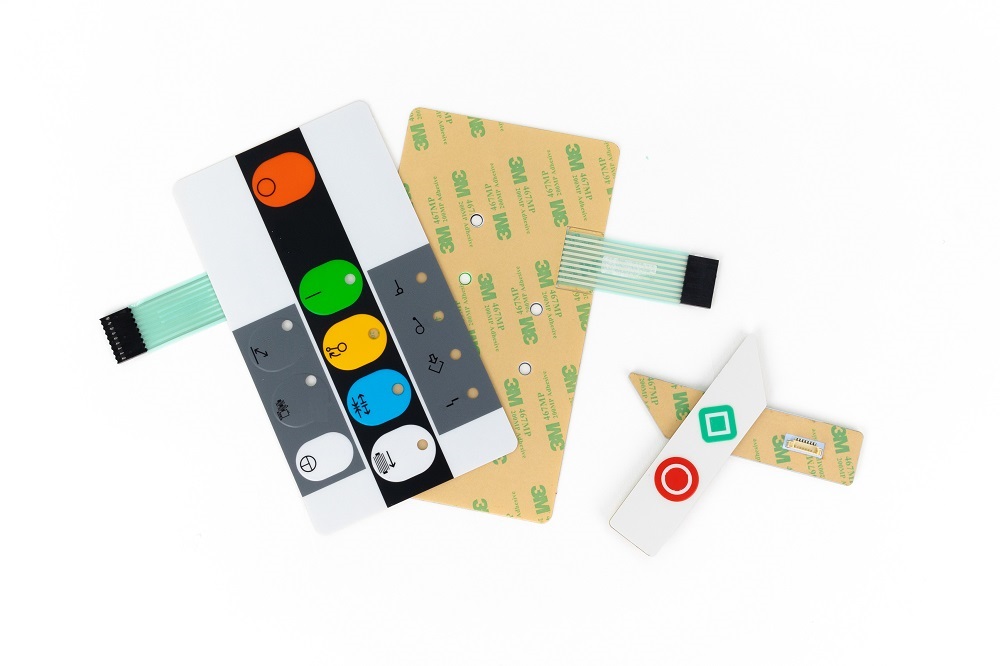Membrane Switch: Reliable, Cost-Effective, and User-Friendly Control Systems
Membrane Switch: Reliable, Cost-Effective, and User-Friendly Control Systems
Blog Article
Understanding Membrane Layer Switches Over: The Key to Long Lasting and Dependable Controls

What Are Membrane Layer Switches?
Membrane layer switches are an innovative remedy in the realm of interface modern technology, integrating functionality and style effortlessly. These tools serve as a user interface between individuals and digital systems, incorporating numerous parts into a small format. Commonly created from flexible, thin layers of materials, membrane layer switches are developed to reply to touch, enabling users to interact with equipment and digital tools properly.
The main components of a membrane button include a printed circuit layer, graphic overlay, and a spacer layer that protects against unplanned activation. The visuals overlay can be tailored to show brand identification or customer preferences, improving aesthetics while making sure functionality. Membrane switches are frequently used in various applications, consisting of clinical gadgets, consumer electronic devices, and industrial devices, owing to their longevity and resistance to ecological factors such as dampness and dirt.
One of the key benefits of membrane layer switches is their capability to endure wear and tear, making them optimal for high-traffic settings. Furthermore, they are light-weight and need marginal space, permitting for innovative styles in item advancement. Overall, membrane changes represent a practical and effective selection for modern-day digital user interfaces, weding innovation with user-centric style concepts.
How Membrane Layer Switches Over Job
The operation of membrane layer switches over rest on a simple yet efficient device that translates user input into electronic signals. These switches contain several layers, typically consisting of a graphic overlay, a spacer layer, and a circuit layer. When a customer presses the button, the leading layer flaws, allowing a conductive component in the circuit layer to reach an equivalent conductive pad on the bottom of the visuals overlay. This get in touch with shuts the circuit and sends an electronic signal to the gadget, showing that the button has actually been triggered.
The style of membrane layer buttons can differ, yet they usually include domes or tactile aspects to give comments to the customer, improving the general experience - membrane switch. The products utilized in membrane layer buttons, such as polyester or polycarbonate, add to their sturdiness and resistance to environmental elements, including moisture and dirt. Additionally, the published circuits are commonly enveloped, which safeguards them from deterioration with time.
Advantages of Membrane Switches

In other addition, membrane switches are known for their sturdiness. Built from robust materials, they are resistant to dirt, wetness, and physical wear, which dramatically expands their lifespan compared to typical mechanical buttons. This durability makes them specifically suitable for high-traffic atmospheres and applications requiring longevity.
Another considerable advantage is the ease of cleansing and upkeep. The smooth surface of membrane switches over minimizes dirt accumulation and is commonly resistant to spills, making them excellent for setups that call for constant sanitization.
Furthermore, membrane switches offer a streamlined account, bring about a thinner layout that can be incorporated right into different devices without adding mass. This attribute not only improves the aesthetic allure yet likewise adds to a more ergonomic item layout.
Applications of Membrane Layer Switches
Straightforward and functional, membrane switches locate applications throughout a large range of sectors, consisting of medical tools, customer electronics, and commercial devices. In the medical area, these switches are integral to tools such as analysis equipment, person tracking systems, and infusion pumps, where integrity and simplicity of cleaning are essential. Their capacity to stand up to harsh settings and preserve performance makes them perfect for such applications.

In customer electronics, membrane switches are read review utilized in products like microwaves, cleaning equipments, and remote controls - membrane switch. Their streamlined style permits for intuitive interface, enhancing the general user experience while offering resilience and resistance to tear and use
Industrial devices likewise benefits from membrane switches, specifically in control panels for equipment and automation systems. These switches provide defense versus dust and wetness, ensuring constant performance in challenging settings. In addition, their personalized attributes permit producers to tailor them to certain operational requirements, boosting efficiency and performance.
Selecting the Right Membrane Change
When picking a membrane button, it is vital to think about numerous aspects that influence efficiency and viability for particular applications. The main factors to consider include environmental problems, tactile responses, longevity, and layout specifications.
First, assess the operating environment; switches subjected to dampness, chemicals, or severe temperature levels need certain products to make certain durability and functionality. Next off, review the need for responsive feedback. Depending upon individual communication, some applications might take advantage of a tactile reaction to confirm activation, while others might favor a non-tactile layout for visual factors.
Sturdiness is an additional critical variable; membrane layer buttons ought to be designed to endure regular usage, influences, and abrasion. Ensure the chosen switch can withstand the anticipated lifecycle, especially in high-usage situations.

Verdict
In verdict, membrane changes offer as essential components in the design of reputable and durable control systems throughout numerous markets. The versatility of membrane switches permits for tailored services that fulfill particular operational requirements, reinforcing their importance in modern-day innovation.
Membrane layer switches stand for an essential aspect of contemporary interface style, mixing performance with resilience in different applications.Membrane layer switches are a sophisticated remedy in the world of user interface innovation, combining functionality and style perfectly. Commonly Source created from adaptable, slim layers of materials, membrane switches are designed to respond to touch, making it possible for customers to communicate with equipment and electronic gadgets efficiently.
The design of membrane layer switches can differ, yet they frequently integrate domes or responsive components to supply comments to the user, enhancing the overall experience.In final thought, membrane switches over offer as important components in the design of trustworthy and long lasting control systems across numerous industries.
Report this page